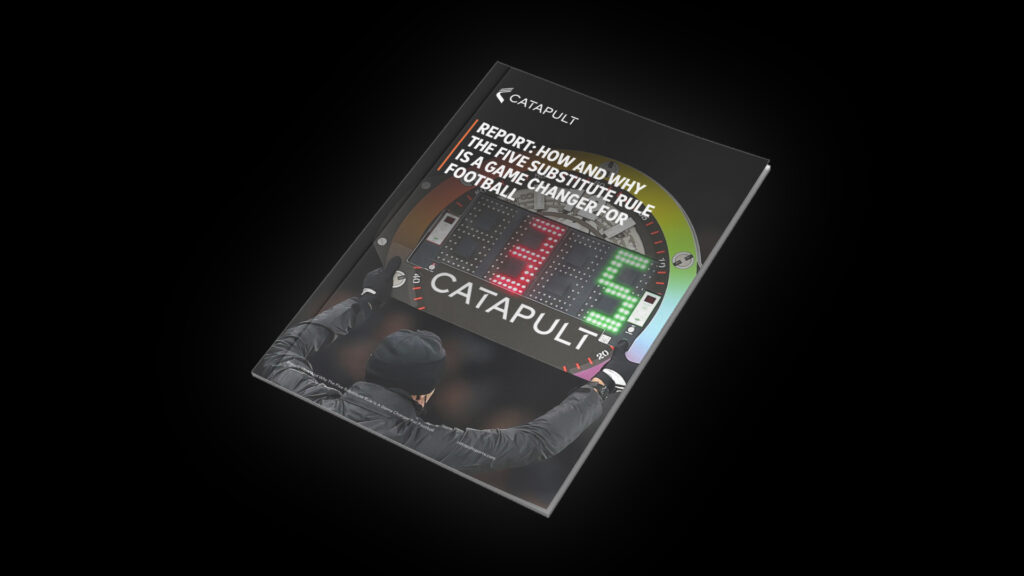Report: How and Why the Five Substitute Rule is a Game Changer for Football
Catapult has teamed up with Chris Barnes, a UEFA Fitness Advisory Group Member, to explain the impact of a recent substitution rule change made by English Premier League clubs.
This rule change will impact a range of stakeholders including, but not limited to, players, clubs, and other leagues and competitions … and so our Report: How and Why the Five Substitute Rule is a Game Changer for Football explores more.
→ Download this report, by clicking here.

What is the Five Substitute Rule in Football?
This report explores the impact of a recent substitution rule change made by English Premier League clubs. For the 2022/2023 season, teams will be able to make five substitutes instead of the traditional three during each match.
The principal driver behind this decision is to mitigate the effects of increased match intensity and fixture congestion, factors which are believed to directly impact player health and welfare.
By reading the report, you can expect to learn:
- How the rule change could impact players, clubs, and other leagues & competitions.
- Why EPL players are 4x more likely to sustain an in-game hamstring injury in December & January than at any other time of the season.
- How much injuries really cost a team, including average player wages lost in a season.
- How athlete monitoring technology can help to mitigate costly injuries.
- Why real-time pitch-side analysis is the future of football performance.
The rule change: Three to Five Substitutes
For the 2022/2023 season, teams will be able to make five substitutes instead of the traditional three during each match. As a result of this rule change, nine substitutes can also be named on the matchday team sheet.

Why change the number of substitutes?
The principal driver behind the decision to amend the number of substitutes is to mitigate the effects of increased match intensity and fixture congestion, factors which are believed to directly impact player health and welfare.
Current research suggests EPL players are 4x more like to sustain an in-game hamstring injury in December and January than at any other time of the season.
Chief Executive of the Players Football Association (PFA), Maheta Molango, said:
“The adoption of the five-substitute rule is a welcome step forward in what needs to be an ongoing effort to address issues with player fatigue, making sure they have the opportunity to perform at their best and to maintain the competitive edge that makes English football the best in the world.”
The Impact of the Premier League Five Substitute Rule on Football
This change by the Premier League will be closely observed by outsiders.
Interestingly, the 2022 World Cup in Qatar presents competing nations with high fixture density coupled with potentially challenging climatic conditions. As such, it will be interesting to see how the increased number of player substitutions is debated across the context of the biggest tournament in the World.

UEFA Fitness Advisory Group Member, Chris Barnes, said:
“I hope the content of this report acts as a starting point for positive conversations within football clubs using the expertise of performance staff to most effectively protect players but also to protect the unique physical attributes of the game.”
→ Download this report, by clicking here.
Substitution in Football: The Role of Data and Technology
Real-Time Pitch-Side Analysis in Substitution Decisions
Substitutions in football have evolved from reactive changes to proactive strategies informed by real-time data. Catapult’s athlete monitoring technology provides managers with precise, actionable insights into player performance and fatigue, allowing substitutions to be optimized for maximum impact.
Catapult’s tools, such as wearable GPS trackers and real-time data platforms, track critical metrics like sprint speeds, distance covered, heart rates, and overall workload. This information is processed instantly, offering a comprehensive view of each player’s physical condition during matches. With these insights, coaches can identify when a player’s performance begins to dip, ensuring substitutions are made at the ideal moment to maintain the team’s competitive edge.
For instance, data showing players nearing their fatigue threshold allows coaches to bring in fresh legs before performance declines. This data-driven approach ensures substitutions not only support individual players but also enhance overall team performance, particularly during high-intensity fixtures.
How Technology Helps Mitigate Injury Risks
While football will always carry the risk of injuries, Catapult’s technology helps mitigate these risks by identifying players who may be at higher vulnerability due to fatigue or workload. Tools like Catapult Vector and its integration with real-time monitoring platforms provide insights into player strain, workload trends, and recovery metrics, enabling coaches to act before minor issues escalate.
For example, the coaching staff can use this information to schedule timely substitutions if a player’s workload data indicates excessive stress or overexertion. This reduces the likelihood of fatigue-related injuries like muscle strains and ensures players are not pushed beyond safe limits during matches.
Catapult’s Pro Video Suite further enhances decision-making by aggregating real-time match data with historical performance trends, giving teams a complete picture of each athlete’s condition. By leveraging these tools, managers can strike a balance between optimizing performance on the field and safeguarding player welfare.
This integration of technology into substitution strategies demonstrates how Catapult’s solutions are transforming football into a sport where data-driven decisions are at the heart of both performance and player protection.
*This content was originally published April 2022 but has since been updated to maintain the accuracy of insight and user experience.